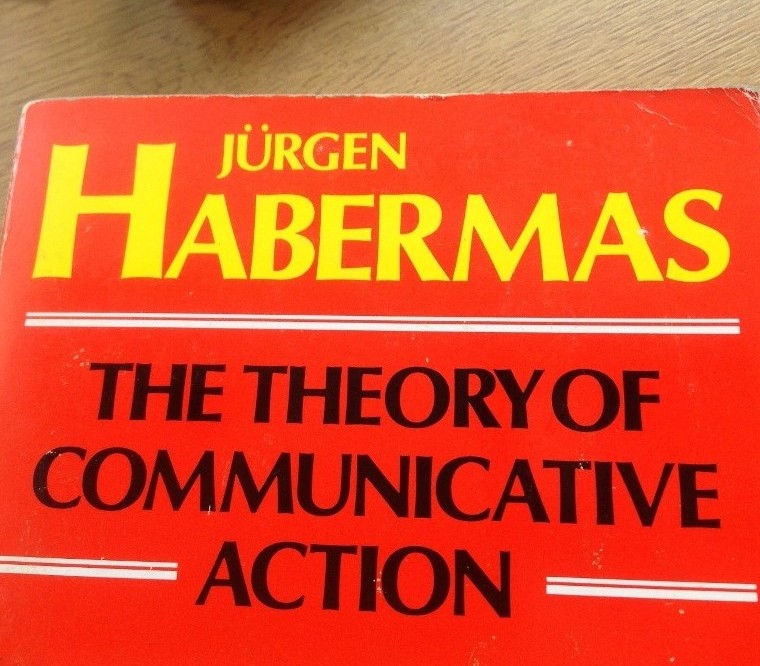[this is the latest post in the series on Parsons and Habermas]
Parsons, according to Habermas (TCA, vol 2, p205), develops his normativist theory of action by critiquing the well-established empiricist account of action. As Habermas puts it, he does this from two sides:
On the one hand, he analyzes the concept of purposive rational action in order to show that utilitarianism cannot ground the acting subject’s freedom of choice (the utilitarian dilemma). On the other hand, he focuses on the concept of instrumental order to show that the question of how social order is possible cannot be resolved under empiricist presuppositions (the Hobbesian problem).
In this statement, Habermas has placed Parsons within the tradition of classical sociological theory (where he belongs) by centering on his attempts to deal with possibly the two key problems in sociological theory, namely, the problem of explaining the autonomy of action and the problem of explaining social order. These two problems are two sides of the same coin in the sense that, as a social theorist attempting to explain how society works, Parsons (and, of course, Habermas himself) needed to provide a plausible account of how, on the one hand, individuals are free to choose between perceived alternatives, while, on the other, there is order in society (It is his attempt to account for them both at the same time that leads Habermas to construct his system-lifeworld distinction).
It is evident that Parsons is dealing with similar issues to Habermas, in that he wants to explain how action is connected to values, and how action becomes integrated in a social order. As we see above, Parsons uses the empiricist tradition as a jumping off point to construct his own theory of action, one which he believes will rectify the problems associated with this tradition. In place of the utilitarian concept of purposive rational action, he posits a voluntaristic concept of action (p205), which he believes will insert the missing link in the chain of means, ends and conditions, i.e., values. It is important to note here that Parsons’ problem with the utilitarian concept of action is that it is deterministic, in that it cannot deal with the subject’s own orientation to values in the selection of means and ends. Habermas summarizes Parsons’ position on page 210:
So long as normative orientations relate only to the effectiveness of means and the success of action (referring to purposive rational action – MM), so long as, beyond such decision maxims, no values are permitted to regulate the selection of ends themselves, the utilitarian model of action leaves room for two opposed interpretations, which are equally deterministic, that is to say, incompatible with the postulate of freedom of choice. Both positivistic and rationalistic attempts to explain the process of setting ends leads to an assimilation of ends to conditions that empirically determine actions. In the one case, ends are reduced either to innate or to acquired dispositions … . In the other case, setting ends is viewed as a function of the knowledge an actor has of his situation … . Neither the rationalistic nor the positivistic interpretation of the utilitarian model of action can explain how an actor can make mistakes in a sense other than the purely cognitive.
So, what Parsons hopes to accomplish is to set out a concept of action that allows for the subject’s own orientation to values, or, if you like, normative standards. The problem, according to Habermas, however, is that Parsons, while explaining the function of values in terms of action, cannot explain the meaning of these values to the actor. And, as Habermas states (p20), there is a particular reason for this:
The elements of ‘ends’, ‘means’, and ‘conditions’ suffice to specify the function of value standards; they are supposed to regulate decisions in the dimensions of setting ends and choosing means. But Parsons cannot explain what it means for an actor to orient his decisions to values so long as he restricts his analysis to the basic unit of action.
So here we return to the problem of the monadic concept of action which Habermas has explained as the first important decision of Parsons’ theory construction. It appears that although Parsons wants to avoid viewing action strictly in terms of purposive rationality, he still
held on to the core of the utilitarian concept of action, interpreting the actor’s freedom of decision as a choice between alternative means for given ends (p214).
By doing this, Parsons sets himself squarely, intentionally or not, within the tradition of the philosophy of consciousness, a philosophy that Habermas is attempting to leave behind and instead replace it with a philosophy of language or communication. Habermas refers to this problem in Parsons’ conceptual framework on page 207 where he states that the
concept of a normative action orientation cannot be clarified in an action-theoretical framework that extends only to the orientations of isolated actors.
Now, when it comes to Parsons’ construction of a normativistic concept of order, as opposed to the instrumental order of the empiricist tradition, it appears that, according to Habermas, Parsons is generally on the right track, taking as he does Durkheim’s view of a social order, i.e.,
that the actions of a plurality of actors can be satisfactorily coordinated only on the basis of intersubjectively recognized norms (p207).
This is opposed to the Hobbesian notion of order which views order as produced through external sanctions alone, and here, as Habermas points out (p212), Parsons is in agreement with Durkheim, Weber, and also Locke. The point here is that an actor’s orientation to purposive rational action cannot provide on its own the base for a normative consensus, a consensus which is essential to the fabric of a social order. As Habermas explains (p212);
[A]ggregating the various calculations of means-ends relations, which every actor undertakes on the basis of his empirical knowledge and with an orientation to his own success, can at best result in everyone regarding it as desirable that a common norm be followed. But a norm’s desirability does not explain the obligating force of valid norms, which is based not on sanctions but on intersubjective recognition, motivated by reasons, of reciprocal expectations of behaviour.
This is Habermas’s summation of Parsons’ analysis, but it would also suffice as a summation of his own conceptualization. So it isn’t with this concept of a normativistic order that Habermas has a problem. It is when this concept of order (the action-system) is connected to Parsons’ conception of the unit act, i.e., the voluntaristic concept of action, that the problems really surface.
Parsons was on the right track when it came to action and order, but failed to connect the two levels together. He could not do this because, going back to the quote at the beginning of this section, he treated intersubjectively shared values as applied after the orientation to action. These values are internalized, yes. They do not simply work as external sanctions, but what Parsons neglects, according to Habermas, is the notion that actors have no choice but to act intersubjectively, or if you like, interact. This is what first makes social interaction possible, and this is why Habermas would like to replace the philosophy of consciousness with a philosophy of language or communication. According to Habermas, Parsons, by relying on a subjective model of orientations to values, has no mechanism
that could explain how action systems get constructed out of action units (p215).
It is because of this that Parsons rearranged his theory of action and this rearrangement is the subject of the next set of readings.










